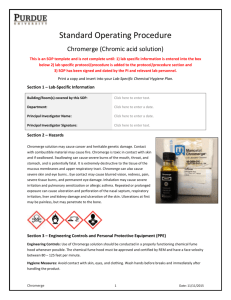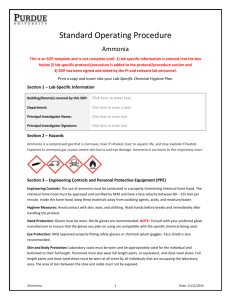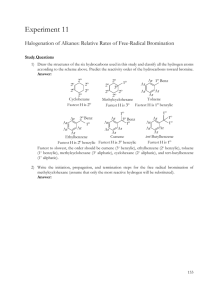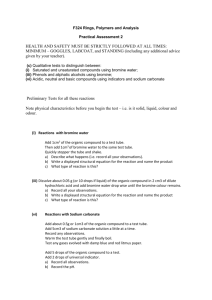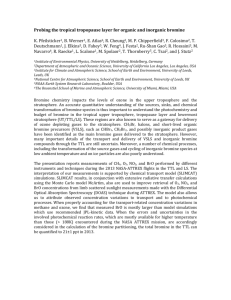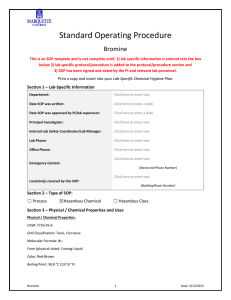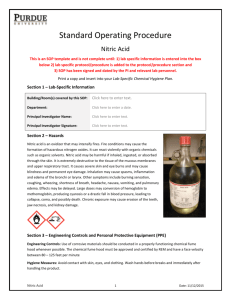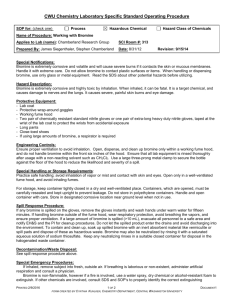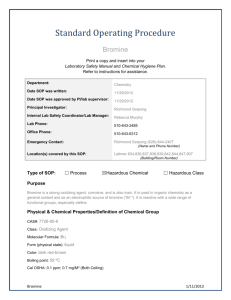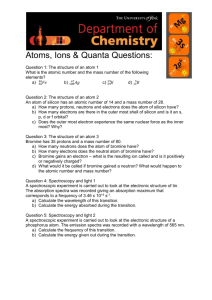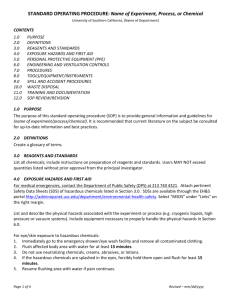Bromine
advertisement
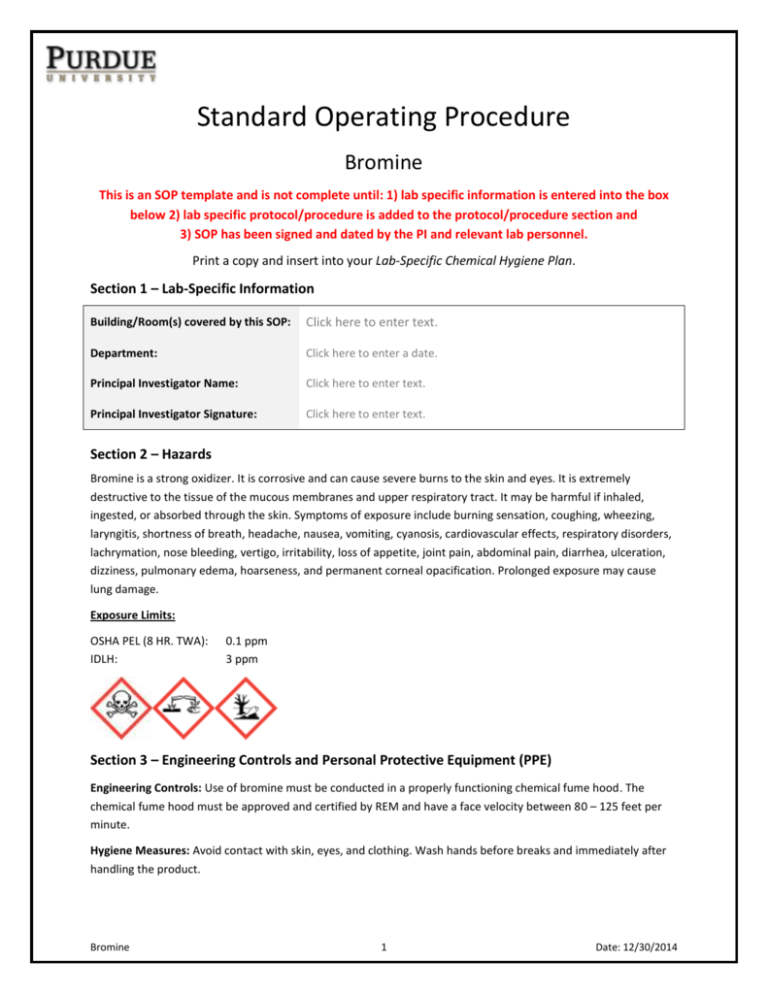
Standard Operating Procedure Bromine This is an SOP template and is not complete until: 1) lab specific information is entered into the box below 2) lab specific protocol/procedure is added to the protocol/procedure section and 3) SOP has been signed and dated by the PI and relevant lab personnel. Print a copy and insert into your Lab-Specific Chemical Hygiene Plan. Section 1 – Lab-Specific Information Building/Room(s) covered by this SOP: Click here to enter text. Department: Click here to enter a date. Principal Investigator Name: Click here to enter text. Principal Investigator Signature: Click here to enter text. Section 2 – Hazards Bromine is a strong oxidizer. It is corrosive and can cause severe burns to the skin and eyes. It is extremely destructive to the tissue of the mucous membranes and upper respiratory tract. It may be harmful if inhaled, ingested, or absorbed through the skin. Symptoms of exposure include burning sensation, coughing, wheezing, laryngitis, shortness of breath, headache, nausea, vomiting, cyanosis, cardiovascular effects, respiratory disorders, lachrymation, nose bleeding, vertigo, irritability, loss of appetite, joint pain, abdominal pain, diarrhea, ulceration, dizziness, pulmonary edema, hoarseness, and permanent corneal opacification. Prolonged exposure may cause lung damage. Exposure Limits: OSHA PEL (8 HR. TWA): IDLH: 0.1 ppm 3 ppm Section 3 – Engineering Controls and Personal Protective Equipment (PPE) Engineering Controls: Use of bromine must be conducted in a properly functioning chemical fume hood. The chemical fume hood must be approved and certified by REM and have a face velocity between 80 – 125 feet per minute. Hygiene Measures: Avoid contact with skin, eyes, and clothing. Wash hands before breaks and immediately after handling the product. Bromine 1 Date: 12/30/2014 Hand Protection: Chemical-resistant gloves must be worn, nitrile gloves are recommended. Wearing two pairs of nitrile gloves is recommended. NOTE: Consult with your preferred glove manufacturer to ensure that the gloves you plan on using are compatible with the specific chemical being used. Eye Protection: ANSI approved properly fitting safety glasses or chemical splash goggles are required. Skin and Body Protection: Flame resistant laboratory coats must be worn and be appropriately sized for the individual and buttoned to their full length. Personnel must also wear full length pants, or equivalent, and closetoed shoes. Full length pants and close-toed shoes must be worn at all times by all individuals that are occupying the laboratory area. The area of skin between the shoe and ankle must not be exposed. Respiratory Protection: Bromine should never be used outside of a chemical fume hood or glove box; therefore respiratory protection should not be required. Section 4 – Special Handling and Storage Requirements Do not over purchase; only purchase what can be safely stored in the laboratory. Avoid contact with skin, eyes, and clothing. Avoid inhalation of vapor or mist. Avoid formation of dust. Always use inside a chemical fume hood. Use spark-proof tools and explosion-proof equipment. Keep away from heat and sources of ignition- No smoking. Prevent the build-up of electrostatic charge. Handle bromine only with equipment made of Kynar, Teflon, Monel, Pyrex, glass, or lead-lined steel. Keep container upright & tightly closed in a dry and well-ventilated place. Containers which are opened must be carefully resealed and kept upright to prevent leakage. Keep away from incompatible materials such as reducing agents, alkali metals, powdered metals, aluminum, stainless steel, iron, copper, organic materials, aldehydes, ketones, arsenic powder, amines, amides, phenols, alcohol, ammonia, azides, and ozone. Bromine will attack some types of plastics, rubber, and coatings. Use in the smallest practical quantities for the experiment being performed. Containers should remain closed when not in use. Do not store in polyethylene containers. Containers should be labeled appropriately. Label should indicate the name of the chemical(s) in the container. Avoid using chemical abbreviations (acceptable if a legend is present in the lab) and formulae. Section 5 – Spill and Accident Procedures Immediately evacuate area and ensure others are aware of the spill. If there is an imminent threat of a fire, pull the nearest fire alarm station to evacuate the building and dial 911. If personnel have become exposed and need medical assistance, dial 911. Section 6 – Waste Disposal Procedures Store hazardous waste in closed containers that are properly labeled, and in a designated area. Complete a Chemical Waste Pickup Request Form to arrange for disposal by REM; detailed instructions are provided at the following link: http://www.purdue.edu/ehps/rem/hmm/chemwaste.htm. Section 7 – Protocol (Add lab specific Protocol here) Click here to enter text. NOTE: Any deviation from this SOP requires approval from Principal Investigator. Bromine 2 Date: 12/30/2014 Section 8 – Documentation of Training (signature of all users is required) Prior to conducting any work with bromine, the Principal Investigator must ensure that all laboratory personnel receive training on the content of this SOP. I have read and understand the content of this SOP: Name Signature Date Click here to enter text. Click here to enter a date. Click here to enter text. Click here to enter a date. Click here to enter text. Click here to enter a date. Click here to enter text. Click here to enter a date. Click here to enter text. Click here to enter a date. Click here to enter text. Click here to enter a date. Click here to enter text. Click here to enter a date. Click here to enter text. Click here to enter a date. Click here to enter text. Click here to enter a date. Click here to enter text. Click here to enter a date. Bromine 3 Date: 12/30/2014
